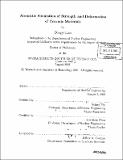| dc.contributor.advisor | Sidney Yip. | en_US |
| dc.contributor.author | Liao, Dongyi, 1975- | en_US |
| dc.contributor.other | Massachusetts Institute of Technology. Dept. of Nuclear Engineering. | en_US |
| dc.date.accessioned | 2006-03-24T18:10:54Z | |
| dc.date.available | 2006-03-24T18:10:54Z | |
| dc.date.copyright | 2001 | en_US |
| dc.date.issued | 2001 | en_US |
| dc.identifier.uri | http://hdl.handle.net/1721.1/30003 | |
| dc.description | Thesis (Ph. D.)--Massachusetts Institute of Technology, Dept. of Nuclear Engineering, 2001. | en_US |
| dc.description | Includes bibliographical references (p. 203-216). | en_US |
| dc.description.abstract | This thesis is a study of atomistic measures of strength and deformation of ceramic materials, utilizing molecular dynamics (MD) simulation that incorporates newly developed theoretical models and computational algorithms to probe the microstructural effects in crystalline, amorphous, and nanocrystalline media. Specific issues of a materials property or mechanics of materials nature are addressed in the context of characterizing the limits to strength and mechanisms of structural failure in two physically rather different model ceramics, SiO₂ described by pairwise ionic interactions and ZrC with many-body covalent interactions. These range from stress-strain responses to various applied loading, determination of fracture toughness, structural relaxation effects, to scaling with grain size. Additionally, a study of the thermal conductivity of ZrC is presented. On the computational side, thesis contributions consist of improved MD algorithms for finding neighbors and integrating the Newton's equations of motion, extension of Ewald summation to a binary ionic lattice for phonon dispersion, elastic constant, and heat current calculations, and a stand-alone scheme for coupled MD-continuum simulations based on domain decomposition and control feedback. The onset of structural instability in MD simulation of an initially defect-free lattice gives not only the theoretical or ideal strength of the deforming material, but also the mode of deformation and details of the structural defects nucleated afterwards. This provides a systematic basis for determining the effects of temperature on mechanical response, and stoichiometry effects in the case of carbon vacancies in ZrCl[sub]1-z. | en_US |
| dc.description.abstract | (cont.) In tensile deformation of quartz, the structural transition from to β phase is observed and analyzed using a pseudo-critical phase transition model, leading to a new interpretation of the structure of the β-quartz. In uniaxial compression of α-quartz a local process of nucleation and growth of disordering is observed which appears to be distinct from the essentially homogeneous crystal-to-amorphous transformation that is well known to occur under hydrostatic compression. This finding also leads to a new interpretation of plastic deformation experiments. Fracture toughness is studied by introducing a pre-existing nanocrack in the simulations and following the details of crack tip extension under mode I loading. Simulations are shown to be quite consistent with the Griffith model in elementary fracture mechanics, confirming on the one hand the brittle nature of these two ceramics while also revealing the effects of surface relaxation, energy dissipation, and surface energy at the atomistic level. Similarly, simulations performed with initial structures with microstructural disorder, in the form of prepared amorphous and nanocrystalline specimens, also lead to new results pointing to the particular mechanisms, void nucleation and growth as well as strain-rate dependence in structural failure of an amorphous specimen, and grain-boundary sliding in shear deformation in very fine-grained nanocrystals. Taken together the thesis results demonstrate the feasibility and utility of the investigation of thermal and mechanical behavior of binary solids at the atomistic level ... | en_US |
| dc.description.statementofresponsibility | by Dongyi Liao. | en_US |
| dc.format.extent | 216 p. | en_US |
| dc.format.extent | 11121535 bytes | |
| dc.format.extent | 11121341 bytes | |
| dc.format.mimetype | application/pdf | |
| dc.format.mimetype | application/pdf | |
| dc.language.iso | eng | en_US |
| dc.publisher | Massachusetts Institute of Technology | en_US |
| dc.rights | M.I.T. theses are protected by copyright. They may be viewed from this source for any purpose, but reproduction or distribution in any format is prohibited without written permission. See provided URL for inquiries about permission. | en_US |
| dc.rights.uri | http://dspace.mit.edu/handle/1721.1/7582 | |
| dc.subject | Nuclear Engineering. | en_US |
| dc.title | Atomistic simulation of strength and deformation of ceramic materials | en_US |
| dc.type | Thesis | en_US |
| dc.description.degree | Ph.D. | en_US |
| dc.contributor.department | Massachusetts Institute of Technology. Department of Nuclear Engineering | en_US |
| dc.contributor.department | Massachusetts Institute of Technology. Department of Nuclear Science and Engineering | |
| dc.identifier.oclc | 55004569 | en_US |
